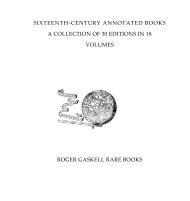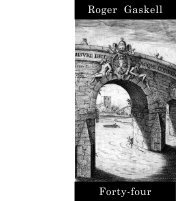pdf - Roger Gaskell Rare Books
pdf - Roger Gaskell Rare Books
pdf - Roger Gaskell Rare Books
You also want an ePaper? Increase the reach of your titles
YUMPU automatically turns print PDFs into web optimized ePapers that Google loves.
plate. Another important plate which is more often reproduced is the one<br />
of a child’s skeleton holding cupid’s arrow (pl. 3) – an original illustration<br />
but following Coïter’s example of a child skeleton. Apart from these original<br />
illustrations, most of the others are after Vesalius, but one is after Coïter, and<br />
Haller thought that some of the Wgures were the results of Platter’s personal<br />
investigations (Choulant p. 216). Herlinger reproduces the Wgure of the base<br />
of the skull beside the Vesalius Wgure, and suggests that some details were<br />
added from Coïter’s illustration and notes that ‘several anatomical details<br />
suggest that the artist must have had a skull before him’ (p. 131).<br />
Felix Platter was born in Basle, studied at Montpellier where he knew<br />
Volcher Coïter, and returned to Basle in 1560 to become professor of medicine.<br />
He explains in his preface that he had been given the opportunity to buy the<br />
Vesalius woodblocks, last used in 1555 and evidently still in Basle, but declined<br />
because their large size would have meant a much larger book, less convenient<br />
to students (see Cushing pp. 97–8 for a translation). Ready reference seems in<br />
fact to have been a major consideration. The text of the Wrst two books of the<br />
work is in tabular form; the third book with a separate title ‘Corporis humani<br />
partium per icones delineatarum explicatio’ contains the 50 plates, many with<br />
several Wgures on each plate and Platter suggests that this section could be<br />
bound separately for greater convenience. ‘Moreover, he has been careful to<br />
place the explanatory legend for each illustrated plate on the [facing] page –<br />
and this is indeed a milestone in the history of medical illustration (Herlinger<br />
p. 130).<br />
The copy. Though browned and soiled this copy is interesting for being<br />
entirely untrimmed. The impressions of the plates are mixed, some quite<br />
strong and black, others rather weak.<br />
Bibliographical note. Cushing gives the Wrst gathering as * 4 : here it is a 4 ($2<br />
signed), suggesting that the whole of the Wrst gathering is reset from the Wrst<br />
issue, not just the titleleaf as Cushing has it. The two preliminary leaves of the<br />
second part are conjugate and probably also both reset (Cushing omits the<br />
second leaf from his collation for both issues). The Wnal leaf of the Wrst part<br />
(<strong>Books</strong> 1 and 2), which is not present here, where present is blank apart from<br />
Froben’s device on the verso. Although often found in the second issue (e.g.<br />
in the Manchester copy) it was presumably excised intentionally as this issue<br />
was published by König, not Froben. Some copies of the Wrst issue [and the<br />
second?] have an engraved portrait of Platter printed on the verso of the title<br />
leaf to the second part (Book 3, the plate section), otherwise blank as here.<br />
154<br />
PORTA, Giambattista della (1535–1615)<br />
De distillatione lib. IX. Quibus certa methodo, multipliciq[ue]<br />
artiWcio, penitioribus naturae arcanis detectis, cuius libet mixti in<br />
propria elementa resolutio, perfectè docetur.<br />
Rome: ex typographia Reu. Camerae Apostolicae, 1608.<br />
4to: ✠4 2✠6 A–u4 , 90 leaves, pp. [20] 154 [6]. Woodcut arms on title<br />
and printer’s device on colophon on u4v, typographic headpieces,<br />
woodcut tailpieces and initials; woodcut diagrams in the text.<br />
Dedications in Hebrew, Greek, Chaldee and Illyrian types, and in







